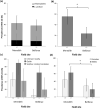Species, sex and geographic variation in chlamydial prevalence in abundant wild Australian parrots
- PMID: 33235241
- PMCID: PMC7686501
- DOI: 10.1038/s41598-020-77500-5
Species, sex and geographic variation in chlamydial prevalence in abundant wild Australian parrots
Abstract
Chlamydia psittaci (order: Chlamydiales) is a globally distributed zoonotic bacterium that can cause potentially fatal disease in birds and humans. Parrots are a major host, yet prevalence and risk factors for infection in wild parrots are largely unknown. Additionally, recent research suggests there is a diverse range of novel Chlamydiales circulating in wildlife. We therefore sampled seven abundant parrot species in south-eastern Australia, taking cloacal swabs and serum from n = 132 wild adults. We determined C. psittaci and Chlamydiales prevalence and seroprevalence, and tested for host species, sex, geographical and seasonal differences, and temporal changes in individual infection status. Across all species, Chlamydiales prevalence was 39.8% (95% CI 31.6, 48.7), C. psittaci prevalence was 9.8% (95% CI 5.7, 16.3) and C. gallinacea prevalence was 0.8% (95% CI 0.1, 4.5). Other Chlamydiales species were not identified to species level. We identified two C. psittaci strains within the 6BC clade, which is highly virulent in humans. Seroprevalence was 37.0% (95% CI 28.5, 46.4). Host species (including crimson rosellas, galahs, sulphur-crested cockatoos and blue-winged parrots) differed in seroprevalence and Chlamydiales prevalence. Galahs had both highest Chlamydiales prevalence (54.8%) and seroprevalence (74.1%). Seroprevalence differed between sites, with a larger difference in males (range 20-63%) than females (29-44%). We reveal a higher chlamydial prevalence than previously reported in many wild parrots, with implications for potential reservoirs, and transmission risks to humans and other avian hosts.
Conflict of interest statement
The authors declare no competing interests.
Figures


Similar articles
-
Chlamydial diversity and predictors of infection in a wild Australian parrot, the Crimson Rosella (Platycercus elegans).Transbound Emerg Dis. 2021 Mar;68(2):487-498. doi: 10.1111/tbed.13703. Epub 2020 Jul 14. Transbound Emerg Dis. 2021. PMID: 32603529
-
Disease surveillance in wild Victorian cacatuids reveals co-infection with multiple agents and detection of novel avian viruses.Vet Microbiol. 2019 Aug;235:257-264. doi: 10.1016/j.vetmic.2019.07.012. Epub 2019 Jul 18. Vet Microbiol. 2019. PMID: 31383310
-
The prevalence of Chlamydia psittaci in confiscated Psittacidae in Colombia.Prev Vet Med. 2022 Mar;200:105591. doi: 10.1016/j.prevetmed.2022.105591. Epub 2022 Feb 3. Prev Vet Med. 2022. PMID: 35149317
-
[Avian chlamydiosis (parrot disease, psittacosis, ornithosis)].Tijdschr Diergeneeskd. 2012 Sep;137(9):588-93. Tijdschr Diergeneeskd. 2012. PMID: 23025204 Review. Dutch. No abstract available.
-
Global prevalence of chlamydial infections in birds: A systematic review and meta-analysis.Prev Vet Med. 2021 Jul;192:105370. doi: 10.1016/j.prevetmed.2021.105370. Epub 2021 May 5. Prev Vet Med. 2021. PMID: 33984601
Cited by
-
Chlamydia Psittaci ST24: Clonal Strains of One Health Importance Dominate in Australian Horse, Bird and Human Infections.Pathogens. 2021 Aug 11;10(8):1015. doi: 10.3390/pathogens10081015. Pathogens. 2021. PMID: 34451478 Free PMC article.
-
Detection of Chlamydia psittaci in the Genital Tract of Horses and in Environmental Samples: A Pilot Study in Sardinia.Pathogens. 2024 Mar 7;13(3):236. doi: 10.3390/pathogens13030236. Pathogens. 2024. PMID: 38535579 Free PMC article.
-
Psittacosis: An Underappreciated and Often Undiagnosed Disease.Pathogens. 2023 Sep 15;12(9):1165. doi: 10.3390/pathogens12091165. Pathogens. 2023. PMID: 37764973 Free PMC article. Review.
-
A Review of Chlamydial Infections in Wild Birds.Pathogens. 2021 Jul 28;10(8):948. doi: 10.3390/pathogens10080948. Pathogens. 2021. PMID: 34451412 Free PMC article. Review.
-
Health parameters for wild Carnaby's cockatoo (Zanda latirostris) nestlings in Western Australia: results of a long-term study.Conserv Physiol. 2024 Feb 20;12(1):coae005. doi: 10.1093/conphys/coae005. eCollection 2024. Conserv Physiol. 2024. PMID: 39898298 Free PMC article.
References
-
- Artois M, et al. In: Management of Disease in Wild Mammals. Delahay RJ, Smith GC, Hutchings MR, et al., editors. Berlin: Springer; 2009. pp. 187–214.
Publication types
MeSH terms
LinkOut - more resources
Full Text Sources

